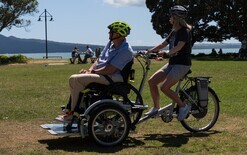Population growth partly due to net migration
New Zealand’s population grew by 100,400 in the year ended June 2017, the largest ever increase for a June year. New Zealand’s estimated resident population was 4.79 million at 30 June 2017. Net migration (arrivals minus departures) contributed 72,300 people to the growth, along with 28,100 from natural increase (births minus deaths). New Zealand’s current gain from net migration equates to 15 people per 1,000 population. Much higher net migration rates were experienced in the late 1870s. Similar rates to today were also experienced in the early 1900s and early 2000s. “Our current net migration rate is high by New Zealand standards, but historically it has fluctuated more than other countries,” population statistics senior manager Peter Dolan said. “At the moment we’re experiencing rates similar to Australia's in 2009.” Over the last five years New Zealand’s population grew by nearly 390,000, more than the population of Christchurch city, to reach 4.79 million in June 2017, Stats NZ said today. Last year’s growth of 100,400 came from 28,100 natural increase (births minus deaths) and 72,300 net migration (arrivals minus departures). “Half of last year’s growth was in the 15–39 age group,” population statistics senior manager Peter Dolan said. “This reflects the contribution of migration to our population growth, with net migration of 50,000 among those aged 15–39 years.” As a result of recent migration flows, the share of New Zealand’s population aged 15–39 years rose from 33 percent in 2013 to 34 percent in 2017. This is a reversal of the trend that saw the share drop from 41 percent in the mid-1980s. Growth of the broad 65+ age group continues to accelerate, up 25,000 in the last year, as the large birth cohorts of the 1950s-early 1970s begin to reach those ages. The population at the oldest ages is also growing, reflecting decreasing death rates at all ages over a long period of time. The 90+ population is now 30,000 compared with 20,000 in 2007. It is projected to reach 40,000 in the late 2020s and 50,000 in the early 2030s.





